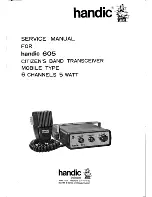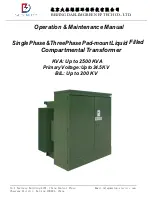
Page 168
FT
DX
9000MP O
PERATION
M
ANUAL
RF
μ
-T
RF
μ
-T
RF
μ
-T
RF
μ
-T
RF
μ
-T
UNING
UNING
UNING
UNING
UNING
U U U U U
NITS
NITS
NITS
NITS
NITS
(MTU-160, MTU-80/40, MTU-30/20
MTU-160, MTU-80/40, MTU-30/20
MTU-160, MTU-80/40, MTU-30/20
MTU-160, MTU-80/40, MTU-30/20
MTU-160, MTU-80/40, MTU-30/20)
μ
-T
UNE
Inspection of the illustrations to the right will demon-
strate the profound advantage of the
μ
-Tune circuit. In
illustration [A], the gray area represents the passband
of a typical fixed bandpass filter covering the 1.8 ~ 3
MHz range; this is typical of the kind of bandpass fil-
ter found in many high-quality HF receivers today. Note
also the hypothetical distribution of signals across the
160-meter band.
In illustration [B], note the narrow white segment within
the gray passband of the fixed BPF. These narrow seg-
ments represents the typical bandwidth of the
μ
-Tune
filter, and one can see that the passband has been re-
duced from about 750 kHz in the case of the fixed BPF)
to a few dozen kHz when
μ
-Tune is engaged. The vast
majority of the incoming signals are outside the pass-
band of the high-Q
μ
-Tune filter, and they will not im-
pinge on any of the RF/IF amplifiers, the mixers, or
the DSP. Very strong out-of-band signals like this can
cause Intermodulation, blocking, and an elevated noise
floor for a receiver.
VRF
In this example, illustration [a] depicts a typical fixed
bandpass filter covering 14.5 to 22 MHz, and once
again the gray shaded area depicts the fixed bandpass
filter's frequency coverage. The vertical lines in the
illustration, once again, represent hypothetical signals
throughout this frequency range.
Figure [b] shows the same fixed BPF, with the white
area representing the typical passband of the VRF fil-
ter operating in the same frequency range. Although
the selectivity of the VRF is not as tight as that of the
μ
-Tune filter, the RF selectivity of the VRF preselector
is still magnitudes better than that of the usual fixed
bandpass filter, affording significant protection against
the ingress of high signal voltage from strong out-of-
band signals.
A
A
A
A
A
D
D
D
D
DVICE
VICE
VICE
VICE
VICE
A
B
a
b
14.5MHz
22MHz
FRONT-END BAND WIDTH
14.5MHz
22MHz
VRF BAND WIDTH
1.8MHz
2.5MHz
μ
TUNE BAND WIDTH
1.8MHz
2.5MHz
FRONT-END BAND WIDTH
μ
-Tune and VRF: Comparisons to Fixed Bandpass Filters
With
μ
-Tuning, the center frequency of the filter is continuously
adjustable throughout its operating range, and the quality L/C
components ensure a tight passband due to the high Q of the
circuit. The RF preselection design task involves not only the
selection of quality L/C components, but the crafting of a tuning
mechanism and tuning concept that preserves system Q (thus as-
suring a tight bandwidth) while providing a wide operating fre-
quency range and consistent, automated tuning. The smooth tun-
ing is achieved by varying the inductance over a wide range; this
is accomplished by motor-driving a large 1.1” (28 mm) ferrite
core stack through a 2” high (50 mm) coil structure. Three
μ
-
Tune modules provide coverage of the 160, 80/40, and 30/20
meter bands on the
FT
DX
9000MP
, and the Q of this circuit,
being over 300, yields unmatched RF selectivity for outstanding
rejection of undesired signals.
1
2
3
4
VRF
μ
-T
VRF
50-60 MHz
13.5-14.5 MHz
14.5-22 MHz
6.5-7.5 MHz
1.8-2.5 MHz
22-30 MHz
10-11 MHz
3.5-4 MHz
50-60 MHz
13.5-14.5 MHz
14.5-22 MHz
6.5-7.5 MHz
1.8-2.5 MHz
22-30 MHz
10-11 MHz
3.5-4 MHz
VFO-A
VFO-B
ANTENNA
AN
T
EN
N
A
SEL
EC
T
O
R
BPF
Summary of Contents for FTDX-9000MP
Page 1: ...FTDX 9000MP Operation Manual...
Page 2: ......
Page 125: ...Page 123 FT DX 9000MP OPERATION MANUAL N N N N NO O O O OTE TE TE TE TE...
Page 166: ...Page 164 FT DX 9000MP OPERATION MANUAL N N N N NO O O O OTE TE TE TE TE...
Page 171: ...Page 169 FT DX 9000MP OPERATION MANUAL N N N N NO O O O OTE TE TE TE TE...
Page 175: ...Page 173 FT DX 9000MP OPERATION MANUAL N N N N NO O O O OTE TE TE TE TE...
Page 178: ...Page 176 FT DX 9000MP OPERATION MANUAL N N N N NO O O O OTE TE TE TE TE...











































